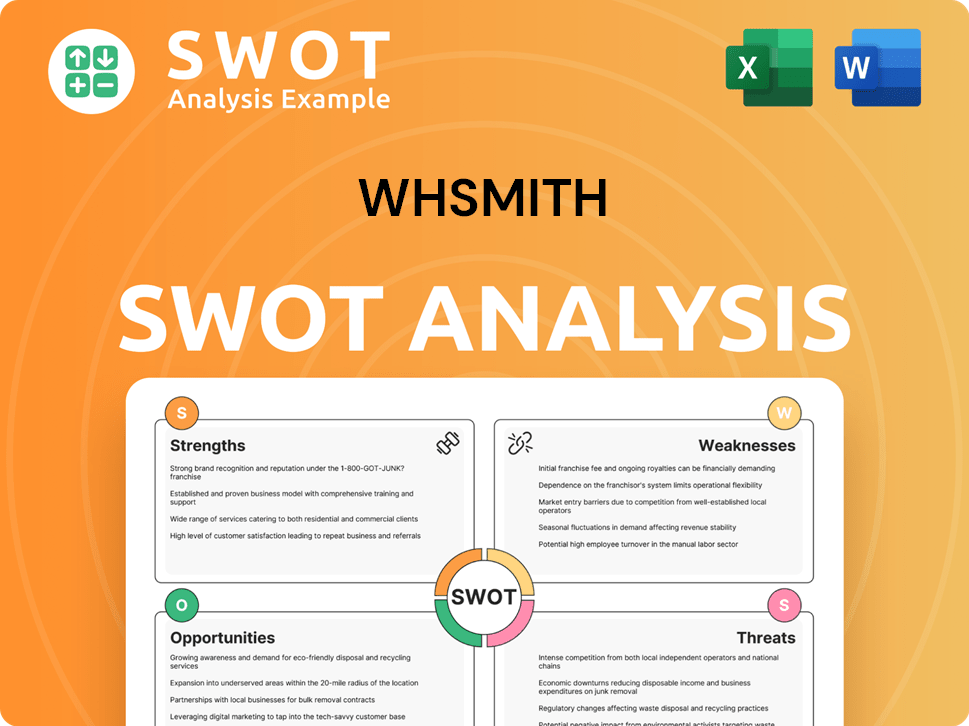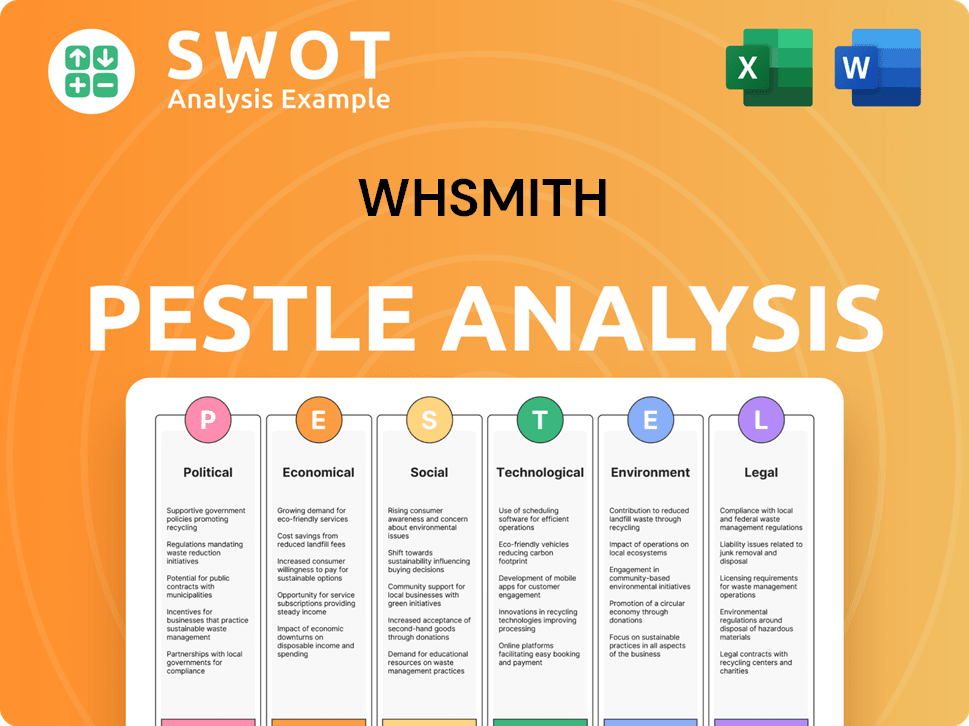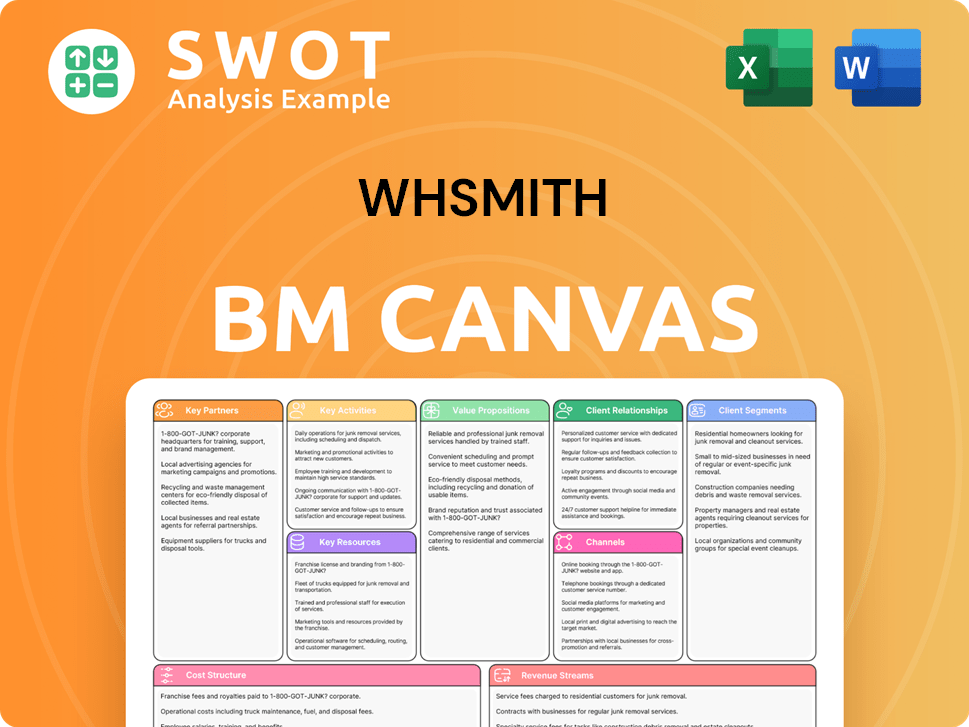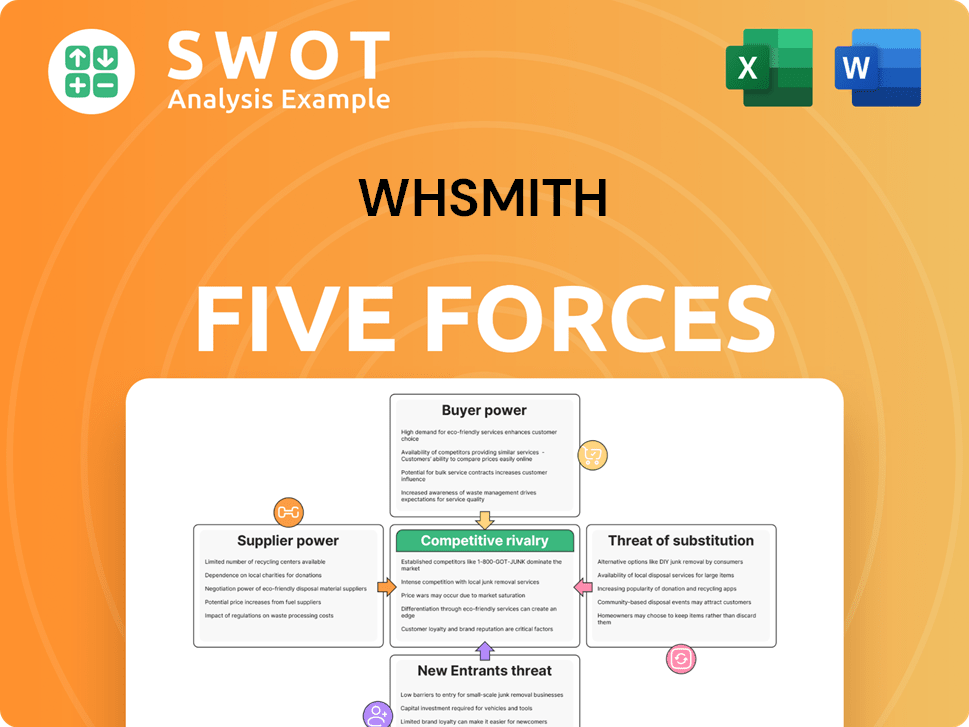WHSmith Bundle
Can WHSmith Thrive in a Shifting Retail World?
WHSmith, a British retail icon, is undergoing a radical transformation. With the planned sale of its UK high street business in March 2025, the 233-year-old company is betting big on global travel retail. This strategic pivot demands a close examination of its competitive positioning and future prospects.

To understand WHSmith's current standing, we must delve into the WHSmith SWOT Analysis, its competitors, and the broader retail industry competition. This deep dive will explore the WHSmith competitive landscape, analyzing its market share analysis, and business strategy competition. We will also examine WHSmith's financial performance comparison and international expansion competition to provide a comprehensive WHSmith market analysis.
Where Does WHSmith’ Stand in the Current Market?
WHSmith has significantly reshaped its business, focusing on its travel retail operations. This strategic shift has solidified its market position, especially in high-traffic locations like airports and train stations. The company's focus on travel retail is evident in its financial results and strategic decisions, making it a key player in the retail industry competition.
The company's value proposition centers on providing convenience and a wide range of products to travelers. This includes books, stationery, food, and health and beauty items. This strategy allows it to capture a captive audience, driving strong sales and profitability. The recent sale of its UK high street business further underscores its commitment to this model.
In the 13 weeks to May 31, 2025, total travel revenue increased by 5% year-on-year and 7% on a constant currency basis. For the six months ending February 28, 2025, Travel division revenues increased by 6% year-on-year to £712 million, with profits surging by 12% to £56 million. In the financial year ended August 31, 2024, the travel business generated £1.466 billion in revenue and £189 million in headline trading profit.
WHSmith operates over 1,700 stores across 32 countries. Its presence is predominantly in airports, train stations, and hospitals. This extensive network allows WHSmith to serve a large customer base and capitalize on the UK retail market. The company's international expansion is a key part of its growth strategy.
The sale of the UK high street business in March 2025 for £76 million allowed WHSmith to concentrate on its travel retail operations. This strategic move has boosted profitability. The company's focus on travel retail is a key factor in its market share analysis.
In the UK, travel revenue was up 5% overall, with like-for-like sales increasing by 6% in the 13 weeks to May 31, 2025. Airport locations showed 7% growth, hospitals 3%, and rail sites 6%. North America revenue increased by 3% (7% at constant currency) and the Rest of the World revenue climbed 9% (12% at constant currency) in the third quarter of 2025.
WHSmith's strengths include a strong presence in high-traffic locations and a focus on travel retail. The company's strategy involves expanding its international footprint and optimizing its product offerings. This approach is detailed further in the Growth Strategy of WHSmith.
- Focus on travel retail boosts profitability.
- International expansion drives revenue growth.
- Strategic divestments streamline operations.
- Strong financial performance supports future growth.
WHSmith SWOT Analysis
- Complete SWOT Breakdown
- Fully Customizable
- Editable in Excel & Word
- Professional Formatting
- Investor-Ready Format

Who Are the Main Competitors Challenging WHSmith?
The Revenue Streams & Business Model of WHSmith are significantly influenced by its competitive environment. Understanding the WHSmith competitive landscape is crucial for evaluating its market position and growth potential. The company's success hinges on its ability to navigate the challenges posed by its rivals in the travel retail and high street sectors.
WHSmith's market analysis reveals a complex interplay of direct and indirect competitors. The company's strategic focus on travel retail, particularly in airports and train stations, places it in direct competition with specialized retailers and convenience stores. The competitive dynamics are constantly evolving, with new entrants and changing consumer preferences impacting the company's performance.
The UK retail market and the broader retail industry competition are key factors shaping WHSmith's business strategy. Its financial performance comparison with competitors highlights the importance of adapting to market trends and consumer demands. The company's ability to differentiate its product range comparison and enhance its customer demographics analysis will be critical for its future growth prospects competition.
In the travel retail sector, WHSmith faces direct competition from global players like Dufry (now Avolta). These competitors offer a wide range of products, from duty-free items to convenience goods. Paradies Lagardère is another significant rival, especially in North American airports.
Indirect competition comes from food and beverage outlets, which compete with WHSmith's confectionery and food offerings. Online retailers also pose an indirect challenge, as travelers can purchase items before or after their journeys.
For books and stationery, WHSmith competes with major bookstore chains and independent retailers. Online giants like Amazon also present significant competition in this category, affecting the stationery market analysis.
Local and regional convenience store chains also compete for travel essential sales within train stations and hospitals. These stores offer quick access to items travelers need, creating localized competition.
WHSmith's strategic sale of its UK high street business to Modella Capital, which will rebrand the stores as TGJones, signifies a shift away from direct competition with traditional high street retailers. This allows WHSmith to focus on its travel segment, where it aims to maintain and grow its market share.
WHSmith's product range comparison reveals a focus on travel essentials, books, stationery, and convenience items. Understanding its customer demographics analysis helps tailor offerings to meet the needs of travelers. The company's strengths and weaknesses are constantly evaluated.
The competitive landscape is shaped by factors such as store locations compared, online presence competition, product range comparison, and brand reputation competition. WHSmith's supply chain competition and international expansion competition strategies also play a crucial role.
- Store Locations: Prime locations in airports, train stations, and hospitals are critical for capturing the travel retail market.
- Online Presence: The company's online presence competition, including its e-commerce platform and digital services, is essential for reaching customers.
- Product Range: Offering a diverse product range comparison, including books, stationery, travel essentials, and food, is key to attracting customers.
- Brand Reputation: Maintaining a strong brand reputation competition and customer loyalty is essential for long-term success.
- Supply Chain: Efficient supply chain management is crucial for ensuring product availability and minimizing costs.
- International Expansion: Expanding into new markets and increasing its international expansion competition is a key strategy for growth.
WHSmith PESTLE Analysis
- Covers All 6 PESTLE Categories
- No Research Needed – Save Hours of Work
- Built by Experts, Trusted by Consultants
- Instant Download, Ready to Use
- 100% Editable, Fully Customizable

What Gives WHSmith a Competitive Edge Over Its Rivals?
The competitive advantages of WHSmith are significantly shaped by its strategic focus on the travel retail sector and its broad operational footprint. The company's widespread presence in high-traffic travel locations, such as airports and train stations, provides a captive audience with immediate needs. This strategic positioning allows WHSmith to capitalize on the constant flow of travelers seeking convenience items and reading materials.
WHSmith's 'one-stop-shop' format in travel locations, encompassing books, stationery, food, and health items, further enhances its appeal to travelers. The company's strong brand equity, built over 230 years, fosters customer trust and loyalty. Continuous innovation and adaptation of product offerings, such as the expansion of food-to-go ranges, demonstrate its agility in meeting evolving customer needs. These strategies are crucial in the dynamic retail industry competition.
Economies of scale derived from its extensive network lead to better purchasing power and operational efficiencies. Ongoing investments in digital initiatives and technology, including a partnership with Xiatech, aim to create a real-time, hyper-connected business. Securing prime retail space in travel hubs often involves long-term contracts, creating barriers to entry for new competitors, solidifying its market position and influencing the WHSmith competitive landscape.
WHSmith operates over 1,700 stores globally, primarily in high-footfall travel locations. This extensive network provides a captive audience and supports strong brand recognition. The strategic placement in airports, train stations, and hospitals ensures consistent customer traffic.
The 'one-stop-shop' format offers a wide range of products, from books and stationery to food and travel accessories. This diverse product selection caters to various customer needs, enhancing convenience. It allows WHSmith to capture a larger share of traveler spending.
With over 230 years of history, WHSmith has built a strong brand reputation, fostering customer trust. This long-standing presence makes it a go-to retailer for travelers. Brand recognition is a key factor in the UK retail market.
Economies of scale and ongoing investments in technology enhance operational efficiency. The partnership with Xiatech aims to create a hyper-connected business. These efficiencies support better purchasing power and streamlined operations.
WHSmith's strengths include its strategic location in travel hubs, diverse product offerings, and strong brand recognition. These factors contribute to its resilience within the retail industry competition. The company's focus on innovation and adaptation, such as the expansion of food-to-go options, is crucial for maintaining its competitive edge.
- Extensive global presence in high-traffic locations.
- A diverse product range catering to traveler needs.
- Strong brand reputation and customer loyalty.
- Ongoing investment in technology and efficiency.
- Growth Strategy of WHSmith focuses on strategic expansion.
WHSmith Business Model Canvas
- Complete 9-Block Business Model Canvas
- Effortlessly Communicate Your Business Strategy
- Investor-Ready BMC Format
- 100% Editable and Customizable
- Clear and Structured Layout

What Industry Trends Are Reshaping WHSmith’s Competitive Landscape?
The WHSmith competitive landscape is significantly influenced by the dynamic retail industry, particularly within the travel sector. The company's strategic focus on travel retail, following the divestiture of its high street business, positions it to capitalize on the projected growth in global travel. This shift allows for concentrated investment and management attention on high-growth areas, aiming to improve customer experiences and operational efficiency.
Risks include economic uncertainties and geopolitical instability, which could impact travel volumes and consumer spending. Maintaining competitive pricing and managing operating costs remain critical challenges. The company's financial performance is also under scrutiny, especially considering a high dividend payout ratio.
The retail industry is experiencing a recovery and continued growth in global travel. Passenger numbers are forecast to increase by 2.5 times between 2024 and 2050. Investment in airport infrastructure worldwide is also increasing, creating more retail opportunities for companies like WHSmith.
Economic uncertainties and geopolitical instability could impact travel volumes and consumer spending. The broader retail landscape faces challenges from increasing online competition and changing consumer preferences. Maintaining competitive pricing and managing operating costs remain critical challenges for WHSmith.
WHSmith is expanding its store network, with plans to open over 90 new stores. The company is also enhancing its digital channels and exploring product innovation, such as new food, health, and beauty ranges. The expansion of its food-to-go offerings and the launch of new concepts like 'Smith's Family Kitchen' also demonstrates adaptability.
WHSmith's pure-play focus on travel retail allows for concentrated investment and management attention on high-growth areas. The company's continued investment in new store openings, refurbishments, and technology aims to improve customer experiences. This strategic focus is expected to strengthen its competitive position.
WHSmith's business strategy competition involves a multi-faceted approach, focusing on travel retail to leverage increasing global travel trends. The company plans to open over 60 stores this financial year. The company's ability to adapt to changing consumer preferences is crucial. For more information, see the Target Market of WHSmith.
- The company's strengths include a focused business model and strategic store locations.
- Weaknesses include exposure to economic uncertainties and high operating costs.
- Opportunities include the growth in travel retail and digital channel enhancements.
- Threats include online competition and changing consumer preferences.
WHSmith Porter's Five Forces Analysis
- Covers All 5 Competitive Forces in Detail
- Structured for Consultants, Students, and Founders
- 100% Editable in Microsoft Word & Excel
- Instant Digital Download – Use Immediately
- Compatible with Mac & PC – Fully Unlocked

Related Blogs
- What are Mission Vision & Core Values of WHSmith Company?
- What is Growth Strategy and Future Prospects of WHSmith Company?
- How Does WHSmith Company Work?
- What is Sales and Marketing Strategy of WHSmith Company?
- What is Brief History of WHSmith Company?
- Who Owns WHSmith Company?
- What is Customer Demographics and Target Market of WHSmith Company?
Disclaimer
All information, articles, and product details provided on this website are for general informational and educational purposes only. We do not claim any ownership over, nor do we intend to infringe upon, any trademarks, copyrights, logos, brand names, or other intellectual property mentioned or depicted on this site. Such intellectual property remains the property of its respective owners, and any references here are made solely for identification or informational purposes, without implying any affiliation, endorsement, or partnership.
We make no representations or warranties, express or implied, regarding the accuracy, completeness, or suitability of any content or products presented. Nothing on this website should be construed as legal, tax, investment, financial, medical, or other professional advice. In addition, no part of this site—including articles or product references—constitutes a solicitation, recommendation, endorsement, advertisement, or offer to buy or sell any securities, franchises, or other financial instruments, particularly in jurisdictions where such activity would be unlawful.
All content is of a general nature and may not address the specific circumstances of any individual or entity. It is not a substitute for professional advice or services. Any actions you take based on the information provided here are strictly at your own risk. You accept full responsibility for any decisions or outcomes arising from your use of this website and agree to release us from any liability in connection with your use of, or reliance upon, the content or products found herein.